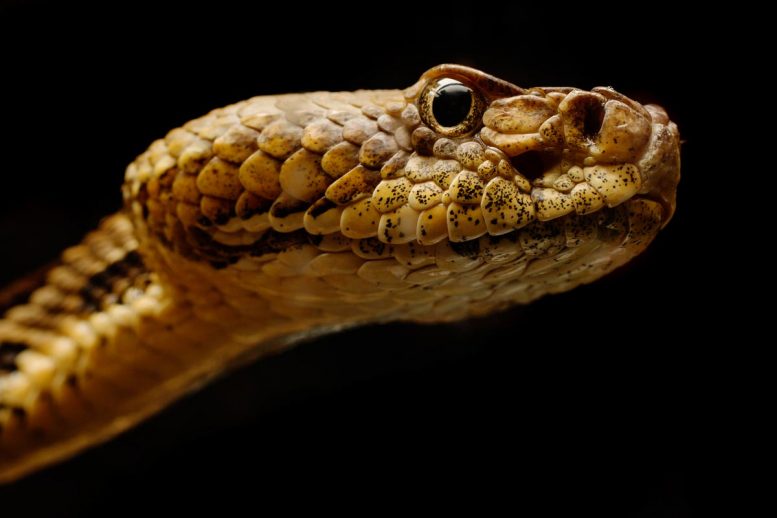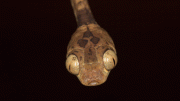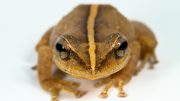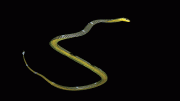
A new study finds a wide distribution of Ophidiomyces ophidiicola, a fungal pathogen that afflicts more than 30 species of snakes, including the timber rattlesnake, pictured. This emerging disease is sometimes fatal to snakes. Credit: Photo by L. Brian Stauffer
In a collaborative effort between scientists and personnel on military bases in 31 states in the continental U.S. and Puerto Rico, researchers surveyed for an infection caused by an emerging fungal pathogen that afflicts snakes. The effort found infected snakes on military bases in 19 states and Puerto Rico, demonstrating that the fungus is more widely distributed than was previously known. The team reports the findings in the journal PLOS ONE.
“Ophidiomycosis — formerly known as ‘snake fungal disease’ — is an emerging infectious disease caused by the fungus Ophidiomyces ophidiicola,” said Dr. Matt Allender, a professor in the veterinary diagnostic laboratory at the University of Illinois Urbana-Champaign who led the new study. “It has been documented in over 15 genera of wild and captive snakes. Infection with the pathogen causes a wide range of clinical signs in snakes, from difficulty shedding skin, to crusts and ulcers on the head and body, and even death in some cases.”
Allender is the director of the Wildlife Epidemiology Lab at the U. of I. and an expert on ophidiomycosis.
“We looked for this pathogen in samples from 657 snakes and found that 17% were infected. Our findings include the first reports of this disease in Oklahoma, Idaho and Puerto Rico,” he said.
The team tested swab samples taken from snakes representing 58 species. The researchers used a qPCR assay they developed, which amplifies the DNA in small samples to detect and measure the extent of infection. Biologists who collected the samples also inspected the snakes for scabs or other signs of disease. The scientists detected the pathogen in samples from 113 snakes representing 25 species including copperheads, eastern diamondback rattlesnakes, Puerto Rican boas, sidewinders and whip snakes.
“Adults had greater odds of being diagnosed with ophidiomycosis than younger snakes,” the researchers reported. “Snakes from Georgia, Massachusetts, Pennsylvania, and Virginia all had greater odds of ophidiomycosis diagnosis, while snakes from Idaho were less likely to be diagnosed with the disease.”
This likely reflects a larger distribution of this disease in snakes in the eastern U.S. than previously thought, and its possible expansion from east to west, Allender said. The disease was first confirmed in 2006 in a population of timber rattlesnakes in New Hampshire.
Snakes worldwide are suffering as a result of habitat loss, climate change and infectious diseases like ophidiomycosis. Their health and abundance are important to human health, as snakes control populations of small mammals that carry and amplify pathogens that also cause disease in humans such as hanatavirus and Lyme disease, Allender said.
Natural lands on military bases provide an unexpected sanctuary for many threatened or endangered species, he said.
Previous studies by project co-investigators with the Department of Defense have found that amphibian and reptile species living on DOD lands represent nearly two-thirds of the total native amphibian and reptile species documented in the continental U.S.
“Ophidiomycosis has potentially serious consequences for the success of snake conservation efforts in North America, threatening biodiversity across several habitats,” Allender said.
Reference: “Ophidiomycosis, an emerging fungal disease of snakes: Targeted surveillance on military lands and detection in the western US and Puerto Rico” by Matthew C. Allender, Michael J. Ravesi, Ellen Haynes, Emilie Ospina, Christopher Petersen, Christopher A. Phillips and Robert Lovich, 8 October 2020, PLOS ONE.
DOI: 10.1371/journal.pone.0240415
The Department of Defense Legacy Program funded this research.









So a sneaky fungus just comes out of nowhere to plague our unsuspecting snakes?
Very Interesting.
Was wondering if there is any Connection with fungal infection in Human skins and private parts.
A few facts with respect to Covid 19 come to mind.
1. Women are less susceptible to Covid 19 than men.
2. Drinking lots of water reduces fungal infection in humans.
3 Remember seeing a 104 year Italian Women having survived the Covid 19 Infection and attributing it to staying well hydrated.
Sometimes the solution lies in the outliers….? Worth exploring?
It’s time each country in the world to unite with other countries and within their borders make wide, animals only nature pathways that connect to other pathways in surrounding countries where animals can freely without fear of humans travel around many thousands of miles! Us humans can put up feed and water stations, wash stations, scratch posts or scratch walls and mats, observation cameras to pick out and help animals needing help as well as providing protection from humans. We can even set up mirrors, toys, slides, animal water fun parks, and many other things that animals will find entertaining and seek to investigate which leads to so much to see for a government to profit from the reality show that can be set up to see the animals throughout America and the world which will constantly have many viewers. Feed the animals, water the animals, give the animals somewhere to live and roam for many miles free of fear from humans and dangers! Is that too much to ask? Why the hell haven’t you people done it already? Do it now because the animals of the Earth need our help now and the governments need us the PEOPLE to rise up and get it done! Now everybody get off your ass and let’s get to work and get this done NOW!!!!!!! Our animals are dying!!!!